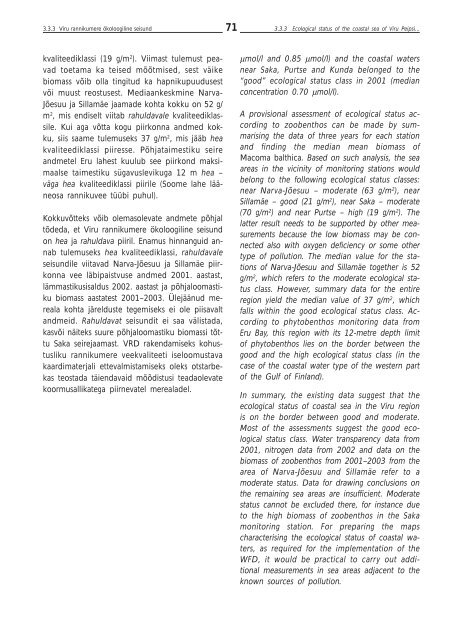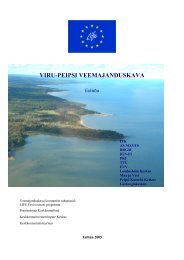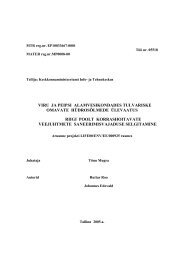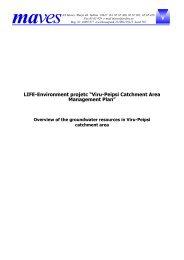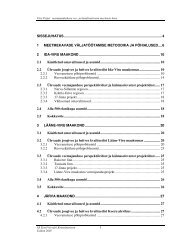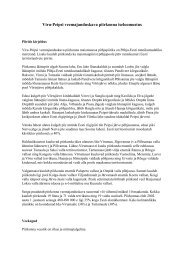Viru-Peipsi veemajanduskava - Keskkonnaministeerium
Viru-Peipsi veemajanduskava - Keskkonnaministeerium
Viru-Peipsi veemajanduskava - Keskkonnaministeerium
Create successful ePaper yourself
Turn your PDF publications into a flip-book with our unique Google optimized e-Paper software.
3.3.3 <strong>Viru</strong> rannikumere ökoloogiline seisund<br />
71<br />
3.3.3 Ecological status of the coastal sea of <strong>Viru</strong> <strong>Peipsi</strong>...<br />
kvaliteediklassi (19 g/m 2 ). Viimast tulemust peavad<br />
toetama ka teised mõõtmised, sest väike<br />
biomass võib olla tingitud ka hapnikupuudusest<br />
või muust reostusest. Mediaankeskmine Narva-<br />
Jõesuu ja Sillamäe jaamade kohta kokku on 52 g/<br />
m 2 , mis endiselt viitab rahuldavale kvaliteediklassile.<br />
Kui aga võtta kogu piirkonna andmed kokku,<br />
siis saame tulemuseks 37 g/m 2 , mis jääb hea<br />
kvaliteediklassi piiresse. Põhjataimestiku seire<br />
andmetel Eru lahest kuulub see piirkond maksimaalse<br />
taimestiku sügavuslevikuga 12 m hea –<br />
väga hea kvaliteediklassi piirile (Soome lahe lääneosa<br />
rannikuvee tüübi puhul).<br />
Kokkuvõtteks võib olemasolevate andmete põhjal<br />
tõdeda, et <strong>Viru</strong> rannikumere ökoloogiline seisund<br />
on hea ja rahuldava piiril. Enamus hinnanguid annab<br />
tulemuseks hea kvaliteediklassi, rahuldavale<br />
seisundile viitavad Narva-Jõesuu ja Sillamäe piirkonna<br />
vee läbipaistvuse andmed 2001. aastast,<br />
lämmastikusisaldus 2002. aastast ja põhjaloomastiku<br />
biomass aastatest 2001–2003. Ülejäänud mereala<br />
kohta järelduste tegemiseks ei ole piisavalt<br />
andmeid. Rahuldavat seisundit ei saa välistada,<br />
kasvõi näiteks suure põhjaloomastiku biomassi tõttu<br />
Saka seirejaamast. VRD rakendamiseks kohustusliku<br />
rannikumere veekvaliteeti iseloomustava<br />
kaardimaterjali ettevalmistamiseks oleks otstarbekas<br />
teostada täiendavaid mõõdistusi teadaolevate<br />
koormusallikatega piirnevatel merealadel.<br />
µmol/l and 0.85 µmol/l) and the coastal waters<br />
near Saka, Purtse and Kunda belonged to the<br />
“good” ecological status class in 2001 (median<br />
concentration 0.70 µmol/l).<br />
A provisional assessment of ecological status according<br />
to zoobenthos can be made by summarising<br />
the data of three years for each station<br />
and finding the median mean biomass of<br />
Macoma balthica. Based on such analysis, the sea<br />
areas in the vicinity of monitoring stations would<br />
belong to the following ecological status classes:<br />
near Narva-Jõesuu – moderate (63 g/m 2 ), near<br />
Sillamäe – good (21 g/m 2 ), near Saka – moderate<br />
(70 g/m 2 ) and near Purtse – high (19 g/m 2 ). The<br />
latter result needs to be supported by other measurements<br />
because the low biomass may be connected<br />
also with oxygen deficiency or some other<br />
type of pollution. The median value for the stations<br />
of Narva-Jõesuu and Sillamäe together is 52<br />
g/m 2 , which refers to the moderate ecological status<br />
class. However, summary data for the entire<br />
region yield the median value of 37 g/m 2 , which<br />
falls within the good ecological status class. According<br />
to phytobenthos monitoring data from<br />
Eru Bay, this region with its 12-metre depth limit<br />
of phytobenthos lies on the border between the<br />
good and the high ecological status class (in the<br />
case of the coastal water type of the western part<br />
of the Gulf of Finland).<br />
In summary, the existing data suggest that the<br />
ecological status of coastal sea in the <strong>Viru</strong> region<br />
is on the border between good and moderate.<br />
Most of the assessments suggest the good ecological<br />
status class. Water transparency data from<br />
2001, nitrogen data from 2002 and data on the<br />
biomass of zoobenthos from 2001–2003 from the<br />
area of Narva-Jõesuu and Sillamäe refer to a<br />
moderate status. Data for drawing conclusions on<br />
the remaining sea areas are insufficient. Moderate<br />
status cannot be excluded there, for instance due<br />
to the high biomass of zoobenthos in the Saka<br />
monitoring station. For preparing the maps<br />
characterising the ecological status of coastal waters,<br />
as required for the implementation of the<br />
WFD, it would be practical to carry out additional<br />
measurements in sea areas adjacent to the<br />
known sources of pollution.


